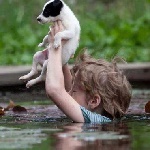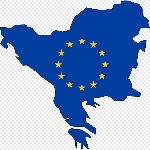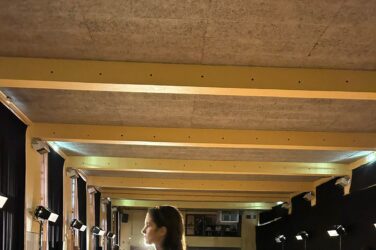It seemed the worst of the floods in the Balkans had passed. But there could be far more trouble ahead – and not the kind you’ll be warned of in weather reports…
Three months after the floods and water pumps are still running
The drive along the road from Zenica, over Zavidović, to Maglaja, showed just how badly the floods had distorted the landscape in Bosnia. Dams, newly improvised yet already half-ruined and blackened, rose high along the banks of the river Bosna. This same river which had always provided irrigation turned to devastate the land in a matter of hours, endangering populations for a hundred kilometres.
When the river level fell, it left little more than tyres, washing machines and trash in the riverbed. Up on the hills, crooked houses offered an even more terrifying sight, while the roads alongside had crumbled down to a single lane.
Three months after the floods first hit the region, the extent of the damage is still visible, and water pumps are still running – pumping water from residential buildings, offices and schools. In the houses near the river, a heavy line carved by the water serves a grim reminder.
Without doubt, the floods of May 2014 caused terrifying destruction across entire regions in Serbia and Bosnia and Herzegovina, leaving numerous people with nothing but the fact that they survived. Three months after the floods, people continue to go without proper shelter: those who still have a home cannot yet return there, while others can only wait for the levees to be taken down to find their homes buried under an avalanche of dirt. Overall, damages and economic losses amount to around €2 billion in Bosnia and Herzegovina and €1.5 billion in Serbia.
On 16 July, 2014 delegations of over 60 countries and 23 international organisations gathered in Brussels to hold a Donors Conference for Bosnia and Herzegovina and Serbia and managed to mobilise pledges of €809.2 million for Bosnia and Herzegovina and €995.2 million for Serbia, most of which actually came in the form of loans, while only a small part in grants. The only problem is, however, until now, no concrete plans have been formed as to how to invest this money in recovery and reconstruction; therefore, this help has yet to reach those in need.
Setting priorities for renewals is not easy: schools are destroyed, the infrastructure is badly damaged, water and energy supplies need restoration, and landslides threaten to sweep away more houses and roads every day; on the other hand, the improvised dams in Bosnia having given up again in the beginning of August to more devastation, the weather forecasts have yet to cease terrifying people. Yet it is just as import to provide the necessary help to flood victims on their way back to “normality” as it is to work on the implementation of flood prevention, flood risk management, and infrastructural repair. The public continues to wait for official government statements on the matter.
In the northern part of Bosnia, reconstruction is still in progress. Thanks to foreign investments, at least the rebuilding of schools and kindergartens and the restoration of water and energy supplies are making quick progress, as in the case of the city of Maglaj. On the other hand, villages away from main roads and major cities are making slow progress; and even this slow progress is happening thanks to individual efforts, since the distribution of reconstruction funds from the Federal government of Bosnia and Herzegovina has not found its way to these areas, though it was promised.
But people in Bosnia and Herzegovina are used to slow bureaucracy and the long process of dividing every cent into three equal parts, which often causes more damage than good. Municipalities have taken reconstruction into their own hands, and though the work is making slow progress, at least the immediate existential needs of most of the people affected have been answered.
Besides the material, a spiritual restoration is needed
The cultural center “Edhem Mulabdić” in Maglaj along the bank of the river Bosna was first to suffer the water torrents. The adjoining movie theatre, sports hall and library are now completely devastated, and the air inside the building complex remains heavy with moisture and antiseptics.
Rašida Muhić, director of the cultural center and a social worker, who was in Maglaj during the floods (which she described as “apocalyptic”), is anxious about the future of the people who experienced this misfortune. “You hear people, your neighbors, scream in agony because they and their children are hungry and terrified. You are three metres away, but you cannot help for the dirty, brown water in between, laden with trash and snakes, threatening to carry away anything else with which it comes into contact. Days spent in clearing thick layers of mud, removing dead animals off the terrain, all while fearing the lurking threats of contagion, landmines and landslides – all of these factors affect people; and we cannot forget that we are talking about people who recently went through war, and those traumas are not forgotten, either”” she says. Professional help will be needed; people have suffered trauma, again.
But it’s not easy to concentrate on the process of healing when the first instinct is to attempt to restore financial security and provide material livelihoods. For many people who lost their homes and businesses, their business was the first of the two they attempted to recover. That is why in flooded cities, the bars, offices, shops and private practices were the first venues to reopen; though small enterprises were back in business on 1 September, classrooms in some flooded areas remained empty, because the renovation couldn’t be completed.
In Donja Bočinja, a village in the canton Zenica-Doboj, 38 out of the 90 households, the school and the local committee facilities were completely flooded, with water rising up to 1.80m. While the renovation of the small school there is almost finished, the playground remains covered in mud. Milenka lives in Donja Bočinja. Unlike most of her neighbors, she and her five family members renovated their house completely on loans. Her family in total received €600 of financial help, the same amount as the other flood victims in this area, which of course isn’t enough, as Milenka points out. But something else is bothering the residents of Donja Bočinja. Though during the worst of the flooding Serbian returnees and Muslim Bosnians (most of them Wahhabis) forgot their differences to help wherever aid was needed, some of the residents have now started to question the distribution of donations, particularly those of religious and political communities, and the air is again polluted with tensions. And this isn’t just a problem in Donja Bočinja.
The water level is back to normal and so are the human relations
Considering the complicated relationship between religions, nations and constituent entities – the Serbian Republic, the Muslim-Croat Federation and Brčko District – at first it seemed that the floods had brought about a revival in human relationships. It seemed that certain factors which had caused alienation among the people in this region for decades were forgotten and that the only important matter left was to unite and provide all the necessary help.
Aid arrived from all sides. Volunteers, doctors, soldiers, both domestic and foreign, all headed to support the endangered areas. Those who could not go, diligently gathered food, water, blankets, clothes, and toys and sent them to those who needed them most. Posts and tweets reported what victims needed the most, and enabled for those who had lost everything to find accommodation and help. Regions were united. Faith in humanity was restored.
But as the floodwaters receded, old patterns of behavior reemerged. Accusations, corruption, favoritism, separation – exploitation took over, as usual. It is hard to comprehend how everything could be forgotten so fast: the help, unity and understanding. Again thanks to social media it became apparent that donated items were being sold and exported. After that, speculations and accusations about unequal distribution of donations based on national and religious labels started, as well as the questions: Who took more? and Who gave less?
Problems like this do not only occur in everyday human social interaction, but also at the abstract political level. Nationalist politicians did not hesitate to exploit people’s desperate situation and incite hatred. For example, a lot of time and energy was invested to clear up allegations testifying that the Republic of Serbia had received nine times more money for flood victims than the Federation of Bosnia and Herzegovina.
Non-transparent data of donations only exacerbates the matter. Until official records of the distribution are published, they will remain in the center of public attention. The only problem is, not everything is recorded. This, as well as corruption, remains a serious obstacle in the reconstruction. “It was anarchy! People took what they could, the distribution of donations was not recorded in any way,” says professional handball player Mahmut Obralić in disbelief, while describing the situation a few days after the first shock. Is it greed, basic survival instincts, or both? “What compels people to take a stove though they already have one, while there are others who really need one?” he asks.
Authorities and the international community have promised to help, but until this help is ready, people are condemned to their own work and mutual assistance. There is only the hope that the current problems were caused by panic and fear. Perhaps the tensions will subside when the governments of Bosnia and Serbia start developing and implementing concrete plans – but the chances of that look modest.
The second flood wave that hit the region in September is a good reminder of how little has been done in the way of flood prevention since the floods of May. Luckily, this time communities and individuals proved better prepared, and the damage was reduced to a minimum.
Cover photo: Svjetlana Rezo





